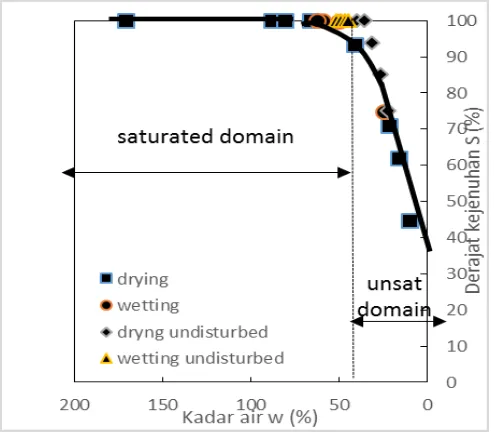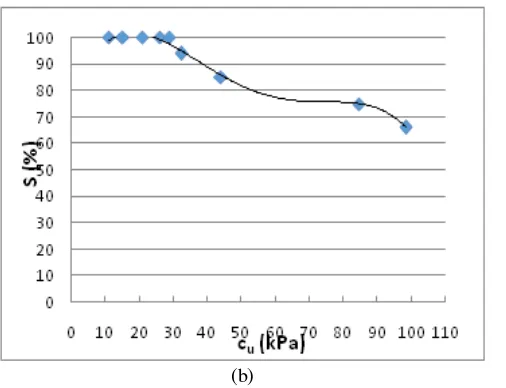Behavior of Expansive Soil under Water Content Variation and Its Impact
to Adhesion Factor on Friction Capacity of Pile Foundation
Daniel Tjandra
Ph.D. Candidate, Civil Engineering Department, Sepuluh Nopember Institute of Technology (ITS), Petra Christian University [email protected]
Indarto
Professor, Civil Engineering Department, Sepuluh Nopember Institute of Technology (ITS), [email protected]
Ria Asih Aryani Soemitro
Associate Professor, Civil Engineering Department, Sepuluh Nopember Institute of Technology (ITS) [email protected]
Abstract
In the active zone, expansive soil could change from liquid to solid state due to evaporation and from solid to liquid state due to water infiltration. This situation affected the carrying capacity of the friction pile, as well as all the soil parameters, especially the value of soil cohesion and adhesion factor between soil and pile material. In this study, a series of laboratory experiment were conducted considering variation of water content and the effect on pile adhesion factors in expansive soil. Adhesion factor measurement was performed using pile model, made from steel and concrete, in the laboratory. The results showed that, in saturated condition, the adhesion factor of concrete pile had a relatively constant value (the value of about 0.9). This value decreased slightly sharp (at value of about 0.6) at the time of Air Entry Value state (AEV) when soil was changed from saturated to unsaturated condition. The value of adhesion factor again increased (at value of about 0.8) until soil water content exceeded the plastic limit, where soil was in semi solid state. After that, this value constant remained until soil water content reached the shrinkage limit. On the other hand at the same range where the adhesion factor on concrete pile showed a decline, adhesion factor on steel pile material sharply increased. This value dropped back to coincide with the adhesion factor value of a concrete pile as soil water content reached the plastic limit and soil enter into semi solid phase.
Keywords: Water Content Variation, Expansive Soil, Adhesion factor
Introduction
Adhesion factor is an important parameter in determining the carrying capacity of friction piles when pile foundation is embedded on the clayey soil. Errors in determining the adhesion factor may cause miscalculation in the friction capacity of pile foundation. There were several charts develop by some studies such as American Petroleum Institute, Tomlinson, Peck, Woodward, Kerisel, Dennis and MacCharty. It showed the relationship between undrained shear strength and adhesion factor. The graphs is shown in Figure 1 [1].
In determining soil undrained shear strength, soil could be in saturated or unsaturated conditions. The graph on Figure 1, which was proposed by some authors, was not clearly explained the soil condition. On the other hand, undrained shear strength of clayey soil greatly depend on variations in soil water content [2-6]. The presence of water into soil could lead soil into liquid, plastic, semi-solid, or solid condition, which was ranged with liquid, plastic or shrinkage limit. In that condition, soil could undergo a phase of saturated, unsaturated or completely dry condition. This condition affected the adhesion factor value. Beside of that, the adhesion factor graphs shown at Figure 1 also was not distinguished pile material such as concrete or steel material.
This research tried to understand the behavior of expansive soil when subjected to water content variations and also the impact to adhesion factor value on friction capacity of pile foundation. The experimental research was conducted by pile modelling at laboratory under drying and wetting process.
Figure 1. Adhesion Factor [1]
The initial characteristics of soil sample such as: water content, specific gravity, liquid limit, plastic limit, soil particle, and soil classification by Unified Soil Classification System (USCS) were shown in TABLE 1.
TABLE 1. Initial Characteristics of Soil Sample [7]
Soil Properties Initial
Undrained Shear Strength, cu (kg/cm2) 0.26 Soil Classification (USCS) CH
To understand the general characteristics of soil when water content variation occurred on expansive soil at Citraland, drying-wetting cycle experiments were performed by Badawi and Indarto [5]. The initial state of the liquid condition was started when water content was 1.5 times the liquid limit of the soil (WL = 114 %, PL = 32 %, PI = 82 %). Characteristics of variation of water content on expansive soil was compared with the variation of water content of the undisturbed expansive soil specimen at Citraland area.
In order to determine the bearing capacity of friction pile, a loading test model was conducted at the laboratory as shown in Figure 2. Undisturbed soil sample was taken by pipe tube
with a diameter of 15.24 cm (6”) and a length of 15 cm.
Concrete and steel model piles were made with a diameter of 1 cm and a length of 30 cm. As shown in Figure 2, a model pile was inserted to the soil sample tube to only investigate its friction capacity [7]. The soil sample tube was made by PVC with 15.24 cm in diameter considering the boundary effect of 15 times the pile diameter [8-9].
Laboratory pile modeling was done on expansive soil with water content variation to investigate the effect on adhesion factors. The influence of variations in water content on expansive soil was represented by two different pile materials, i.e. concrete and steel. Soil water content under drying and wetting process can be seen at TABLE 2.
TABLE 2. Drying and Wetting Condition
Drying-Wetting Condition Water Content (%)
Wetting 15 % 51.18
Figure 2. Loading Test at Laboratory [7]
Experimental Result
General Characteristic of Expansive Soil under Water Content Variation
transition condition until the soil become unsaturated. These soil conditions had close relationship with the way to determine the adhesion factor of pile foundation.
Figure 4. Drying-Wetting Cycle of Undisturbed Expansive Soil at Citraland [5]
The Effect of Water Content Variation on Adhesion Factor Results of adhesion factor experiments on steel and concrete piles can be seen in
Figure 5. Adhesion factor was gained by dividing friction capacity of pile with undrained shear strength and surface area of pile model. In general, at the beginning, adhesion factor of both materials showed similar values, especially when soil in saturated condition, which was about 0.9. But a different value was then happened at the time when soil changed from saturated into unsaturated conditions. In this phase, adhesion factor for concrete material was declined to about 0.6. This value was relatively constant until the degree of saturation reached about 90%. This value was then increased up to a value of 0.8 with decreasing the degree of saturation. This value remain constant even though the degree of saturation continued to decline.
For steel material in the transition phase of soil from saturated to unsaturated, adhesion factor value was significantly increased up to . After that, adhesion factor value was progressively decreased with decreasing degree of saturation then had a horizontal asymptote with adhesion factor of concrete material in the value . These value remain constant for concrete material, even if the degree of saturation continued to decrease.
Adhesion factor value between soil and steel material was higher than the value between soil and concrete material. This phenomenon was contrary to the understanding of physics and previous studies as disclosed by Tan [11] and Tiwari [12], which stated that the roughness of the surface material affected the friction capacity between soil and materials. Concrete material, which had a greater surface roughness, had
friction capacity of steel material was 42% greater than friction capacity of concrete material. Signor (2012) mentioned that the friction capacity of steel pile was 33% to 50% greater than friction capacity of concrete pile. This phenomenon was unusually behavior of steel material, which had lower roughness than concrete material.
The greater value of adhesion factor in steel material was not enough only considering the surface roughness. The behavior of expansive soil itself should be well understood. First, expansive soil had a high plasticity behavior. High plasticity behavior was obviously increased the soil cohesive. It must be remembered that in this experiment, the soil state was changed from plastic into solid condition. Water content reduction from saturated to unsaturated conditions changed the density of soil. Very high adhesion factor occurred when cohesiveness of this expansive soil was approaching like cement material which had a strong adhesion with steel material.
Second, expansive soil as unsaturated soil, which its pore water pressure was a negative pore water pressure that potentially increased effective soil stress. So that the adhesiveness between soil and steel material was gradually stronger, especially in conditions of pseudo saturation. Learning from the phenomenon of expansive soil at Citraland, the value of adhesion factors was affected by the undrained shear strength. Beside of that, adhesion factor was also greatly influenced by several behavior factors when subjected to water content variations such as: soil plasticity, degree of saturation of the soil and pile material roughness. Thus, the properties of the soil must be observed carefully in order to obtain proper adhesion factor values.
(b)
Figure 5. (a) Relationship between Undrained Shear Strength and Adhesion Factor for Steel and Concrete Pile (b) Relationship between Undrained Shear Strength and Degree of Saturation
Conclusion
From the study of the variation of soil water content on expansive soil at Citraland, it can be concluded that:
1. By doing a general studies of the water content variation, several important things for clayey soil can be determined, such as: shrinkage limits, air entry value, saturated and unsaturated zone.
2. Adhesion factor of clayey soil, especially for expansive soil, was strongly influenced by soil plasticity, saturation levels and also roughness of pile material.
3. In expansive soil, steel pile had greater adhesion factor when it compared with concrete pile, especially when soil condition changed from saturated into unsaturated and soil state changed from plastic into solid state. However, in saturated and unsaturated condition with degree of saturation under 80%, adhesion factor of steel and concrete piles were almost the same.
References
[1] Coduto, D.P., “Foundation Design Principles and
Practices,” New Jersey: Prentice-Hall, Inc, 2001. [2] Yalcin, A., “A Geotechnical Study on the Landslides
in the Trabzon Province, NE, Turkey,” Applied Clay Science, 52, pp. 11-19, 2011.
[3] Au, S.W.C., “Rain-Induced Slope Stability in Hong
Kong,” Engineering Geology, 51, pp. 1-36, 1998. [4] Shayea, N.A., “The Combined Effect of Clay and
Moisture Content on the Behavior of Remolded unsaturated Soils,” Engineering Geology, 62, pp. 319-342, 2001.
[5] Badawi, B., and Indarto, “Behaviour of expansive undisturbed and remolded soil under drying wetting
cycles,” National Conference VI 2010 Civil Engineering ITS, pp. 105-112, 2010.
[6] Indarto, “Kelakuan tanah ekspansif serta akibatnya
pada bangunan dan jalan sederhana,” ITS press, pp 15-23, 2012.
[7] Tjandra D., Indarto, R.A.A. Soemitro, “The effects of water content variation on adhesion factor of pile
foundation in expansive soil,” Civil Engineering
Dimension Journal Vol. 13 No.2, pp 114-119, 2013. [8] A.I. Mhaidib, “Effect of Rate of Loading on Uplift
Capacity of a Model Pile in Clay,” Proceedings of
the Eleventh International Offshore and Polar Engineering Conference, Stavanger, Norway, 2001.
argileux lors de cycles de drainage-humidification,” Revue Frangaise de Geotechnique, No. 41, pp. 63-71, 1988.
[11] Tan W.H, Lee C.Y., Sivadass T., “Behaviour of clay
-steel interfaces,” International conference on
construction and building technology, pp 11-20, 2008.
[12] Tiwari B.,Ajmera B.,Kaya G., “Shear strength reduction at soil structure interface,” GeoFlorida 2010: Advance in Analysis, Modelling & Design, No.41, pp 1747-1756, 2010.
[13] Signor Clayton A., “Driven Pile in Central Texas
Expansive Soils,” Proceeding of the 37th
![Figure 1. Adhesion Factor [1]](https://thumb-ap.123doks.com/thumbv2/123dok/1562893.2050234/1.595.317.551.514.683/figure-adhesion-factor.webp)
![Figure 2. Loading Test at Laboratory [7]](https://thumb-ap.123doks.com/thumbv2/123dok/1562893.2050234/2.595.311.548.72.328/figure-loading-test-at-laboratory.webp)
![Figure 3. Drying-Wetting Cycle of Remolded Expansive Soil at Citraland [5]](https://thumb-ap.123doks.com/thumbv2/123dok/1562893.2050234/3.595.310.558.68.443/figure-drying-wetting-cycle-remolded-expansive-soil-citraland.webp)

